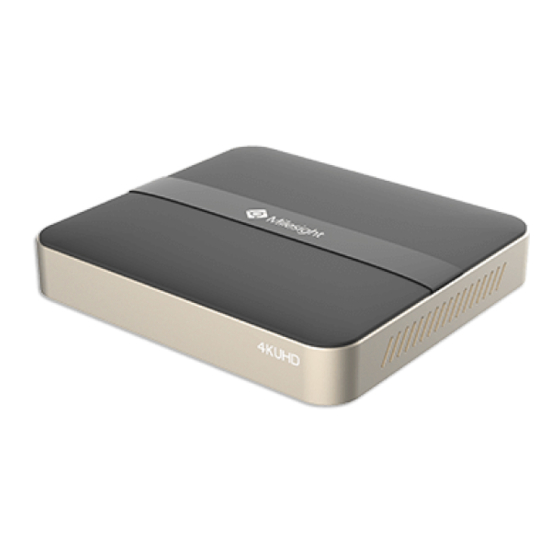
Table of Contents
Advertisement
Quick Links
Advertisement
Table of Contents

Summarization of Contents
1. Product Introduction
1.1 Introduction
Overview of Milesight NVR Series, its OS, and core video management capabilities.
1.2 Product Key Functions
Key features including basic info, monitoring capabilities, and HDD management.
2. Hardware Overview
2.1 Panel Buttons
Visual guide to the hardware interfaces and panel buttons on NVR models.
2.2 USB Mouse Usage
Detailed instructions on how to use a USB mouse for NVR operation and navigation.
2.3 Hard Disk Installation
Step-by-step guide for installing hard disk drives into NVRs.
3. Local Operation
3.1 Wizard Setting
Initial setup wizard to configure essential NVR settings for user-friendliness.
3.2 Live View
How to view live video feeds, including main menu and toolbar functions.
3.3 Playback Functions
How to playback recorded video, events, tags, pictures, and manage files.
3.4 Data Retrieval
3.4.1 Common Backup
How to search and back up recorded video files based on various criteria.
3.4.2 Event Backup
How to search and back up video files associated with specific event types.
3.4.3 Picture Backup
How to search and back up recorded snapshot images.
3.5 Camera Settings
3.5.1 Camera Management
Adding, configuring, and managing network cameras connected to the NVR.
3.5.2 Device Search
Searching for IP devices on the network to add to the NVR.
3.5.3 PTZ Configuration
Configuring Pan-Tilt-Zoom (PTZ) parameters for compatible cameras.
3.5.4 Image Settings
Adjusting image parameters like display, enhancement, day/night, OSD, privacy, and ROI.
3.6 Storage Management
Preparation for Record
Ensuring NVR and HDD are installed and initialized for recording.
3.6.1 Video Record
Configuring video recording schedules for cameras, including continuous and event recording types.
3.6.2 Snapshot
Setting up schedules for capturing still images (snapshots) from camera feeds.
3.6.3 Disk Management
Managing local disks and adding Network Attached Storage (NAS).
3.6.4 RAID Configuration
Configuring Redundant Array of Independent Disks (RAID) for data redundancy.
3.6.5 Hot Spare
Configuring a hot spare disk for RAID array redundancy and automatic rebuild.
3.6.6 Group Management
Dividing disks into groups for storing different channels' recorded files.
3.7 Event Management
3.7.1 Motion Detection
Configuring motion detection, setting sensitivity, detection area, and alarm actions.
3.7.2 Video Loss
Configuring actions for video loss events, including audible warnings and email notifications.
3.7.3 Alarm Input
Configuring actions for external alarm inputs, including recording and audible warnings.
3.7.4 Alarm Output
Configuring actions for external alarm outputs, including trigger delay and name.
3.7.5 Exception Handling
Configuring actions for system exceptions like disk errors or record failures.
3.7.6 VCA Features
Setting up VCA features like Region Entrance, Motion Detection, Tamper, Line Crossing, Loitering, Human Detection, People Counting, Object Left/Removed.
3.8 System Settings
3.8.1 General Settings
Setting general system parameters like date, time, and device name.
3.8.2 Network Settings
Configuring network settings like IP address, DNS, DDNS, Email, P2P, SNMP, HTTPS, and UPnP.
3.8.3 Holiday Settings
Configuring recording or image capture schedules for holidays.
3.8.4 User Management
Adding new users, setting privileges, and managing user accounts.
3.8.5 Maintenance Operations
Firmware upgrade, configuration management, factory reset, auto reboot, and hot spare.
3.9 System Status
3.9.1 Device Information
Viewing device model, MAC, hardware, software version, and uptime.
3.9.2 Network Status
Checking network status, including connection and bandwidth utilization.
3.9.3 Camera Status
Viewing the status of connected cameras, including IP, record, and frame rate.
3.9.4 Disk Status
Checking disk status, capacity, type, and S.M.A.R.T. information.
3.9.5 Event Status
Monitoring camera events (video loss, motion) and alarm status (input/output).
3.9.6 Group Status
Checking the status of created disk groups and their associated channels.
3.9.7 Logs
Checking, searching, and exporting system operation logs.
4.7.6 Packet Capture Tool
Capturing and downloading network packets for troubleshooting.
4. WEB Settings
4.1 Account Setting
Setting up account activation, password, and security questions for NVR access.
4.2 Login Process
Accessing the NVR web interface by entering username and password, including plugin installation.
4.4 Live View
4.4.1 Camera List
Listing and playing added cameras in live view, with descriptions of stream types and modes.
4.4.2 PTZ Operation
Operating PTZ, Preset, Patrol, and Pattern functions for compatible cameras.
4.4.3 Image Configuration
Adjusting image parameters like display, enhancement, day/night, OSD, privacy, and ROI.
4.5 Playback and Backup
4.5.1 How to Playback
Step-by-step guide on how to select channels, stream types, and dates for playback.
4.5.2 Transcoding
Using transcoding for better remote playback performance in various network conditions.
4.5.3 Video Files Backup
Cutting and backing up recorded video files from the NVR.
4.5.4 Picture Files Backup
Backing up recorded snapshot images from video playback.
4.6 System Configuration
4.6.1 Local Configuration
Configuring local settings like file paths, connection type, and play mode.
4.6.2 Camera Management
Adding and managing cameras via Device Search or Camera Management interface.
4.6.3 Storage Configuration
Configuring storage options including video record, snapshot, disk, RAID, and group settings.
4.6.4 Event Configuration
Configuring event detection like motion, video loss, alarms, and VCA features.
4.6.5 System Settings
Setting general system parameters like date, time, network, user, and maintenance.
4.7 Status Monitoring
4.7.1 Device Information
Viewing device model, MAC, hardware, software version, and uptime.
4.7.2 Network Status
Checking network status, including connection and bandwidth utilization.
4.7.3 Camera Status
Viewing the status of connected cameras, including IP, record, and frame rate.
4.7.4 Disk Status
Checking disk status, capacity, type, and S.M.A.R.T. information.
4.7.5 Event Status
Monitoring camera events (video loss, motion) and alarm status (input/output).
4.7.6 Packet Capture Tool
Capturing and downloading network packets for troubleshooting.





Need help?
Do you have a question about the MS-N7016-UPH and is the answer not in the manual?
Questions and answers